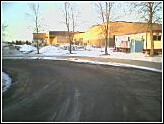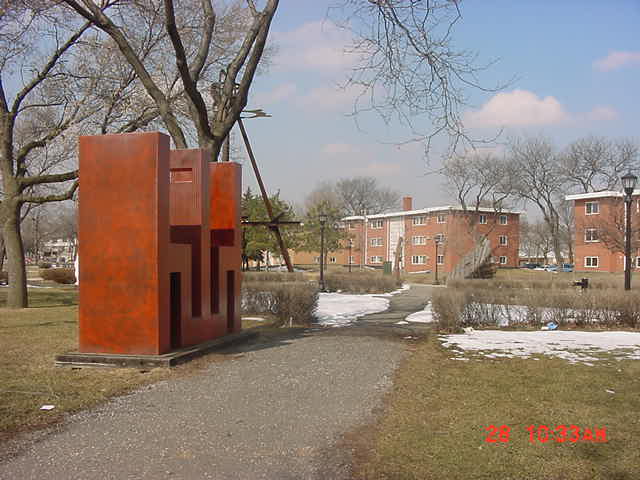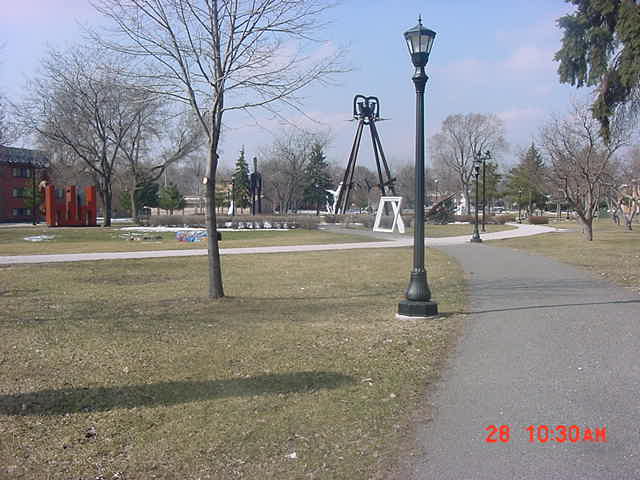

The City of Morris will be opening their newly built elementary school this Fall of 2005. As the city and surrounding community anticipates (some optimistic and pessimistic) this new school, residents are wondering what will be done with the "old" existing historic elementary school building.
Below are some "camera phone" pictures of the New Elmentary School being built->
 (2/9/05)
(2/9/05)  (2/9-southwest side corner)
(2/9-southwest side corner)  (1/29)
(1/29)
 Public Meeting
Public MeetingI decided to make a website after frequent talks on this community issue starting from my attending the BCLP Retreat in Grand Rapids. I want to gather all the information in one site for easier overviews on this.
Possible Community Proposals Overheard/Proposed by Sal:
-housing for multi-purposes: half-way house for ex-convicts; shelter for the homeless, abused women, runaway children, etc..
-Prairie Renaissance Cultural Gallery to host classes through the Morris Community Ed here. Have extra room/space for art exhibits/displays. Also, to host annual concerts/events (e.g. Monroe Crossing)
-Morris Literacy Project to hold their ESL classes anytime during the week or teach Spanish to interested community members (adult, children, etc..)
-Arts and Crafts (e.g. scrap-booking) gatherings that can lead to a business
-Morris Community Church services on Sundays, which they no longer have to be constrained to a certain time anymore. Also, a list of other joint community activities=> ClearbrookSchoolreuseproject1.doc & MorrisCommunityChurchVisionfor1.doc written by Pat Franey, pastor.
*other churches that can be somewhat compared to this project->
Sanctuary Covenant's community/neighborhood outreach program called The Sanctuary Community Development Corporation
-Music Recording Studio for current and future music artists (e.g. Children 18:3, Rictus, Razin' Cain, 13th Floor, and other local bands) [How to Build a Small Budget Recording Studio from Scratch ... With 12 Tested Designs (Paperback)]
-a ethnic store with goods (such as "The Village Emporium", Quantum Connections International (based in Browerville, MN)
-a gathering place (e.g. Tempe Public Library, from "Planning for Success
Ten Examples of Successful Library Collaborative Projects" (maintainitproject.org)
"...offers special opportunities to bring families with young children together and to build social connections between older adults, young parents and relevant community services."
What to do with the Old Elementary School Property
-have two/three story apartment buildings with bottom unit retail spaces (similar to Downtown St. Paul Riverfront Project: Lyon's Court Senior Affordable Housing 60 units w/ retail space on street level #11 (click button) or Prospect Park East River Road: Urbanism by the UofM Twin Cities Campus) for stores/restaurants (Mexican) that college students could walk to easily from the nearby UMM Campus. This might increase the city's economy with easy shopping/spending opportunities with college students-especially those that don't have a car!
-outdoor water park
-put a recreation center outside of the track for uses throughout the year for area children and youth to keep active.
-youth center
-a campus and community collaborative central-neutral meeting place that hosts annual events that "all" are welcome:
I believe if there is a collaborative community effort by local organizations, businesses, churches, etc..., we can keep the old elementary school and help preserve this historical state site that will please the Stevens County Historical Society
Real estate development and a somewhat limited building reuse appear to be the logical fate of the Morris Area Elementary School.
And while there is local interest in the property, a St. Paul consulting firm will continue courting outside interests for the 17-acre property on Columbia Avenue.
A group of Morris citizens met with a St. Paul consulting firm late last week to discuss the elementary school site, which will be vacated this fall when a new $27 million elementary school opens adjacent to the high school.
�There�s potential for local involvement,� said Craig Rapp, vice president of Springsted Inc., which has contracted with the school district to market the property. �We talked about what might be possible from a local perspective.�
Rapp met with nine local business people and representatives of the school board, the City of Morris and the University of Minnesota, Morris in what Rapp terms a �roundtable� discussion with local brokers and leaders.
Various developers in the Twin Cities area also have been contacted about their potential interest in the property, Rapp said.
Springsted will meet again with school district officials to discuss the project in about a month, Rapp said.
Late last year, Rapp and Mike Hoheisel, of Springsted Inc., discussed the elementary school project with the Morris school board, outlining a timeframe and potential future uses for the elementary school property, which this summer was placed on the National Register of Historic Places.
After that meeting, the district set up a reuse committee comprised of school and community members in an attempt to identify and maintain the property�s ties as a communal entity.
The primary task will be getting the property, which costs about $20,000 per month to operate, off the district�s hands and books.
�The goal is to make sure the school district doesn�t have to hang onto the property any longer that it has to,� Rapp said.
Because of the large open acreage available around the building, single-family homes, townhouses or multi-family dwellings appear to make the most sense, Rapp said.
Reusing the building presents a more difficult challenge, he said.
The elementary school is comprised of several different components built at different times, some with more desirable reuse qualities than others.
It�s likely some of the building would be demolished, Rapp said.
City involvement also will be crucial to the future of the property, Rapp said, mostly during the decision-making process and possibly through some type of financing.
�The main things we�re looking at is expansion of the neighborhood and some demolition and reuse of the building,� Rapp said. �But that will be the hard part, right there.�
Morris area realtor Tom Hoffman echoed those sentiments.
�It�s a big, expensive building to tear down, and then you have to figure out what to do with the land,� Hoffman said. �It�s a delicate balance between supply and demand in housing. A lot of people could be hurt if you don�t do the right thing.�
Before any of that is a concern, however, the school district and UMM must reach agreement on the university�s right of first refusal option connected to the 17-acre parcel. Although university officials have informally stated UMM has no interest in the property, Morris schools Superintendent Scott Monson said the district still is working to secure a legal document.
The district also must convince developers it will be worth their time and money, said school board member Vance Gullickson.
Suitable uses need to be identified for at least a portion of the building, and a developer would encounter expenses for demolition and cleanup of a building which has portions nearing 100 years old, he said.
�I feel more positive at this point in time that we can find a fit,� Gullickson said. �But we�re still just doing preliminary ground work to find out the local and non-local interest. We don�t want to leave any rock unturned.�
What becomes a legend most?
07/16/2005
Editor�s note -- This is the first in a series dealing with reuse issues of the former Morris Area Elementary School building.
By Philip Drown
Sun Tribune
Determining the best way to reuse the old Morris Area Elementary School building is no easy task, but it is one the City of Morris appears ready to tackle.
When the city�s Economic Development Authority made the decision to purchase 17.5 acres of land from the school district in May, which included the elementary school building, it did so with eyes wide open to the challenges and the possibilities.
�What�s more important in the city�s eyes is the acreage situated in the middle of town,� said Morris City Manager Ed Larson. �How we develop that is very important to the city.�
Larson, along with many others in the community, hopes that development will be a combined public and private effort. In the coming months, the city will assemble a committee of people able to explore the issues and make solid recommendations.
�We want to bring some people together to help guide the development of that property,� said Larson. �An opportunity like this comes along once in a lifetime. We�ll need a lot of voices at the table giving their input.�
Should tax payers be concerned that the city�s decision to maintain and redevelop the building rather than demolish it right away will translate into a long term draw on their personal income? Not at all, according to Larson.
�We�re looking for the most favorable arrangement for the city,� Larson said. �We want to minimize what costs are there and show a little profit, if possible.�
But, if the school district can�t afford to maintain the building, how can anyone else? The answer is that while the building may be beyond the limits of one public entity to maintain alone, plans on the table for reuse may be more economical in the long term. The key lies in the current strategy to share the burden of the whole by dividing it among many. The city intends to parcel out pieces of the building to other independent and interested parties through land sales, leases, or other arrangements. The city will be seeking ways to develop the building and the land that will offset costs and bring in revenue, rather than add more tax burdens to the community, Larson said. �We�re lining up ideas to explore,� Larson said. �Finding out what�s out there and who�s interested.�
The central location and the historical nature of part of the building make it a prime space for redevelopment. The building and property are listed on the National Register of Historic Places. While any project dealing with the property is still in the early exploration phase and many questions still need answers, there has been no shortage of people seeking ways to utilize the building.
A proposal has already come forth from a local church interested in taking over the historic auditorium and part of the old high school for services, classes, and ministries.
Another proposal, from two University of Minnesota, Morris professors, deals with other portions of the building. The �business incubator� proposal would channel local resources such as UMM, the West Central Research and Outreach Center, the Soils Lab, and others into a program dedicated to growing innovative businesses that would employ local people and generate long term revenue.
Further, Morris�s recent application to the Minnesota Design Team, spearheaded by the Center for Small Towns, highlighted the potential school building and property reuse as �the largest reuse project in the history of the city.�
The Minnesota Design Team is a group of volunteer architects, landscape architects, urban engineers and community planners who help communities build on their strongest assets through community design and planning. Larson indicated that the most developed proposal at the moment is from Morris Community Church. MCC has been meeting in the old auditorium for eights years, after outgrowing their old building. MCC would lease from the city but be responsible for all associated costs of using the property, including maintenance and renovation expenses. However, if no viable projects come forth and no one is willing or able to utilize the building, the city will not be shackled with a boat anchor. They are considering options for all contingencies, including demolition.
The city is currently approaching legislators to include a request for $800,000 in the 2006 bonding bill. The request is something of a fail-safe to cover worst-case scenarios if no building reuse options work out. �Those funds would defray the cost of demolition of the school,� said Larson. If the historical parts of the school are utilized, that would reduce the total demolition cost of the remainder, Larson said.
In the mean time, there is no rush to act without clear thinking. Transfer of ownership will take place Nov. 1, but the city will have a few years to work out details. The building can be maintained at minimum levels, enough to keep the grass cut and the pipes from bursting in winter, for a dollar amount far below previous estimates, Larson said. �At the bare minimum, the lease from the church will defray the cost of maintaining the building,� he said.
The power of an idea: School site ripe for innovation
07/23/2005
Editor�s note -- This is the third story in a series dealing with reuse issues of the former Morris Area Elementary School building.
By Philip Drown
Sun Tribune
Some of Minnesota�s most enduring institutions and significant legacies began with the moment someone seized an opportunity, no matter how unlikely, and said, �Hey, I have an idea!�
The day Earl Bakken and his brother-in-law decided to set up a business in an old railroad boxcar was the day of humble beginnings for Medtronic, Minnesota�s well-known designer of innovative electronic medical devices. Or, the day William McKnight took over a company on the verge of bankruptcy called Minnesota Mining and Manufacturing. With vision and creativity, McKnight took someone else�s black hole and turned it into 3M, the world�s leading supplier of coated abrasive materials. When it comes to bringing forth possible reuses of the former Morris Area Elementary School building, the City of Morris is clearing the table and opening its ears to hear new ideas from creative people.
At a City Council meeting in June, just such an idea came forward during the citizens comments portion of the agenda. Sylke Boyd stood up and spoke of an idea she hatched with her husband, Kevin, suggesting reusing portions of the school to develop businesses by turning it into a �business incubator.�
�It seemed like things were moving very fast with the school at the time,� said Sylke. �Kevin had written this proposal. I showed it to a couple of colleagues and they were very excited about it. We figured we had to submit this now.�
The Boyd�s proposal suggests using the newer portions of the building and forming a non-profit organization called the Morris Area Corporate Innovation Association.
The building would serve as a �center for providing office and small laboratory space, along with shared resources and waste management pools to small and new businesses,� according to the proposal.
The basic concept of a business incubator, in general terms, is a simple one. Enterprising people with ideas for potential business can apply to enter a program that is operated by an organization, usually a collaboration of local government, educational and business institutions.
Such a program will often provide various tools to help the entrepreneur navigate legal issues required for setting up and managing the business. It will also provide space to operate, on-going business counseling and assistance, and shared use of resources such as support staffing and equipment.
The end result is that local businesses that provide jobs to local people are given local support and encouragement to grow locally. Eventually, they might grow large enough to leave the nest that has nurtured them and expand into other space in the community.
Kevin Boyd, a professor of chemistry at the University of New Orleans, has been thinking about this idea for a year -- ever since Sylke began teaching at the University of Minnesota, Morris. He took note of the many resources, agricultural, educational, research, medical, and sheer talent in the area and saw potential.
�It occurred to me that there so much brain power around here,� said Kevin. �A lot of things going on.�
Said Sylke, �We thought this might be a good proposal because it is one that would actually bring in something to the city.�
�Or at least keep it here rather than having people go to the Cities or Chicago or wherever they�re going to create things,� added Kevin.
The Boyd�s proposal, a document of about fourteen pages, lays out a strategy to form this incubator. It suggests who should be involved, what types of businesses could be developed, what may be required to refit the school building, what it would cost, how it could be operated, and where the money would come from.
According to the proposal, the cost would be $17 million over a 10 year period to refit the building for operation, insure and maintain the building, and supply it with a director and staff.
According to the Boyd�s, up to 75 percent of that price tag could be covered by government grants available through the Economic Development Administration of the Department of Commerce. The remaining 25 percent could be covered by grants to private foundations and other means.
Now, does all this mean the City of Morris is making plans to enter into a risky new venture in business start-ups? Of course not. And, for that matter, neither are Kevin and Sylke Boyd.
According to the Boyds, this proposal is an initial idea with a little structure, but it contains enough detail to generate some ideas. They mainly hoped to get the idea on the table and allow it to become part of the discussion.
The core of the proposal is that the Boyd�s looked around Morris with fresh eyes and saw opportunity. If and how such an idea might play out in the end will be determined by the unique nature of Morris as a community and whether or not community leaders found a significant economic pay-off in the future.
In the end, if there are no proposals, there will be no reuse. And that is an option few would like to see occur.
After the Morris Design Team's Presentation this past weekend (October 14th-15th of 2005), I wanted to do a short review of what I heard on the Elem School Property...
It's March 28th 2006, and I just took some pictures of a residential/city park (Capitol Plaza South-subsidized housing) by St. Paul's Capitol on Marion St./I-94 intersection (west of Sears). I thought this might serve as a good example of a proposed "memorial/sculputre garden" (e.g. Minneapolis' ) at the Elementary School Property by the expanded cemetery.



-Related Sites:
Sculpture Gardens: Hirshhorn Museum and Sculpture Garden-Smithsonina (Washington, D.C.), Umlauf Sculpture Garden & Museum (Austin, TX), Broken Green (Murrells Inlet, SC)
Memorial Gardens: Children's Memorial Garden (Manitoba, CA), Lincoln Memorial Gardent (Springfield, IL), Gill Memorial Garden-episcopal church (Pine Meadow, CT)
Event Hosting Gardens: Japanese Garden (Normandale Community College)
Grants/Funding
Models-Examples of other Communities